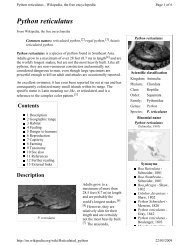Issue Thirteen 30 June 2012 - Taxonomic issue - all - Smuggled.com
Issue Thirteen 30 June 2012 - Taxonomic issue - all - Smuggled.com
Issue Thirteen 30 June 2012 - Taxonomic issue - all - Smuggled.com
You also want an ePaper? Increase the reach of your titles
YUMPU automatically turns print PDFs into web optimized ePapers that Google loves.
Hoser <strong>2012</strong> - Australasian Journal of Herpetology 13:15-34.<br />
Australasian Journal of Herpetology 15<br />
Australasian Journal of Herpetology 13:15-34.<br />
Published <strong>30</strong> <strong>June</strong> <strong>2012</strong>.<br />
INTRODUCTION<br />
The so-c<strong>all</strong>ed Kukri Snakes from south and east Asia got their<br />
name from a distinctively shaped Nepalese knife, which is<br />
similar in shape to the broad, flattened, curved hind teeth these<br />
snakes possess.<br />
These teeth are designed to assist in feeding on eggs, a<br />
dominant part of the diet of many species. They slit open eggs<br />
as they are being sw<strong>all</strong>owed, <strong>all</strong>owing for easier digestion.<br />
These specialized teeth are in addition to the functional venom<br />
glands possessed by the rear-fanged Colubrids. None are<br />
believed to be dangerous to humans.<br />
Available online at www.herp.net<br />
Copyright- Kotabi Publishing - All rights reserved<br />
ISSN 1836-5698 (Print)<br />
ISSN 1836-5779 (Online)<br />
A review of Kukri Snakes, currently referred to the<br />
genus Oligodon Fitzinger, 1826, with a division<br />
into twelve genera, four further subgenera and the<br />
creation of a tribe to ac<strong>com</strong>modate them<br />
(Serpentes:Colubridae).<br />
Raymond T. Hoser<br />
488 Park Road, Park Orchards, Victoria, 3114, Australia.<br />
Phone: +61 3 9812 3322 Fax: 9812 3355 E-mail: viper007@live.<strong>com</strong>.au<br />
Received 18 April <strong>2012</strong>, Accepted 1 May <strong>2012</strong>, Published <strong>30</strong> <strong>June</strong> <strong>2012</strong>.<br />
ABSTRACT<br />
The taxonomy of the Kukri Snakes, long placed in the genus Oligodon Boie, 1827 has<br />
been in urgent need of a taxonomic overhaul for some years.<br />
This paper reviews the approximately 70 recognized species taxa and places them within<br />
twelve (12) genera, only two of which have available names.<br />
As a result ten new genera are created and named according to the Zoological Code.<br />
These are, Smythkukri gen. nov., Cottonkukri gen. nov., Funkikukri gen. nov., Hoserkukriae<br />
gen. nov., Oxykukrius gen. nov., Daviekukri gen. nov., Moseselfakharikukri gen. nov.,<br />
Dannyelfakharikukri gen. nov., Hugheskukri gen. nov. and Ninkukri gen. nov..<br />
Four subgenera are also created, namely Geddykukrius subgen. nov., Sammykukriae<br />
subgen. nov., Crottykukrius subgen. nov. and Harrigankukriae subgen. nov..<br />
Furthermore, the group are sufficiently divergent from other Colubrids to be placed within<br />
their own tribe Oligodonini tribe nov.<br />
Keywords: <strong>Taxonomic</strong> revision; new tribe; new genera; Smythkukri; Hoserkukriae;<br />
Oxykukrius; Cottonkukri; Ninkukri; Hugheskukri; Funkikukri; Daviekukri;<br />
Moseselfakharikukri; Dannyelfakharikukri; new subgenera; Crottykukrius; Sammykukriae;<br />
Geddykukrius; Harrigankukriae; Oligodonini; Kukri snake.<br />
Most species are egg eaters, but they also feed on lizards, frogs<br />
and sm<strong>all</strong> rodents.<br />
They are gener<strong>all</strong>y sm<strong>all</strong> to medium in size, (usu<strong>all</strong>y under 90<br />
cm) innocuous, often move about at night and are most likely to<br />
be found on the floor of mature forests.<br />
Color and pattern varies, but is often bright and distinctive.<br />
There are approximately 70 recognized described species,<br />
although the exact number isn’t certain due to the fact that some<br />
described taxa may be synonymous with others and there’s no<br />
doubt that undescribed forms remain to be named.



